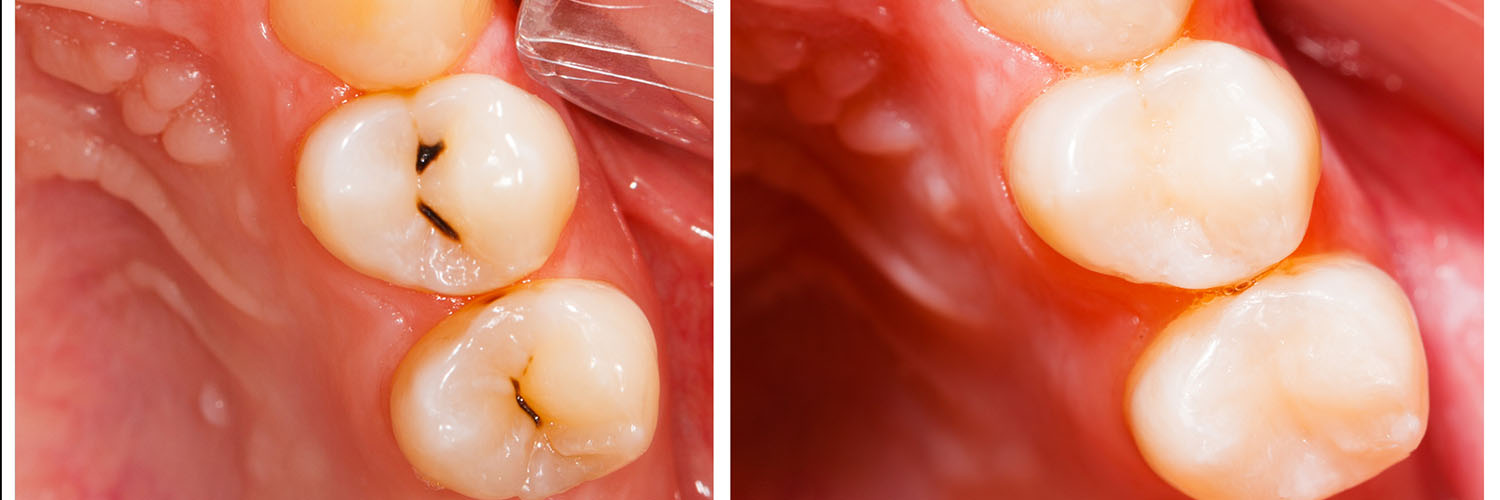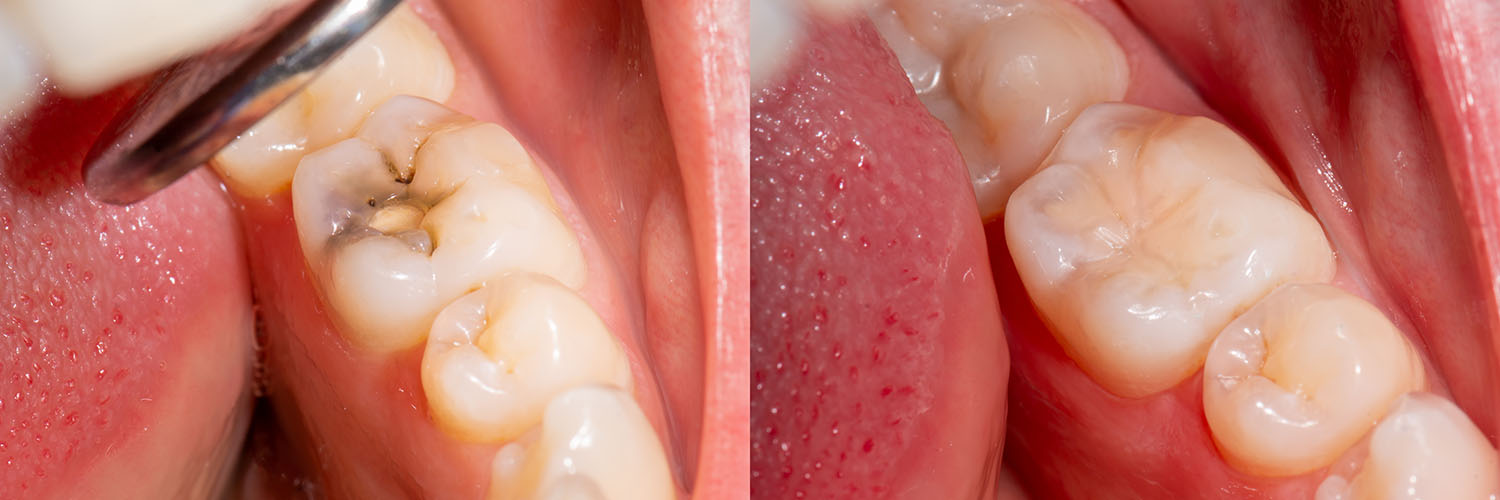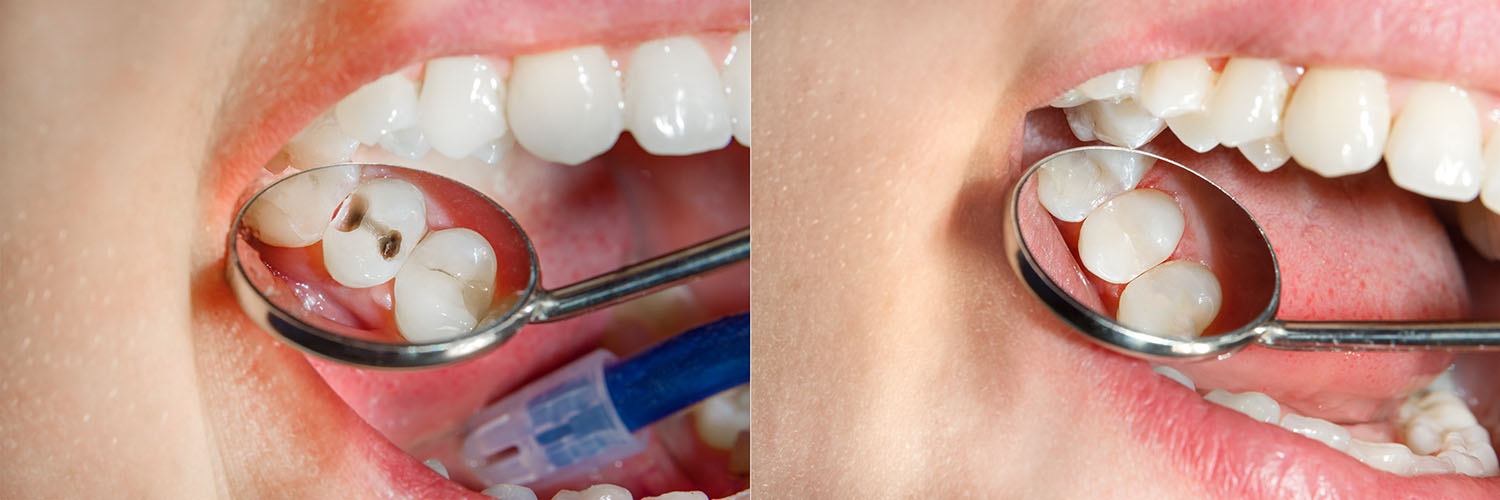When a cavity or minor fracture weakens a tooth, a dental filling restores the tooth’s shape, strength, and ability to function comfortably. Fillings stop decay from spreading, rebuild lost structure, and help preserve the remaining natural tooth so you can chew and smile with confidence.
Tooth decay remains a common health issue across all ages, so filling treatments are among the most frequently performed dental procedures. Despite their routine nature, modern restorative techniques emphasize preservation and comfort—removing only the damaged tissue and reinforcing the tooth in a way that blends with your bite and appearance.
Our goal is to offer restorations that are both durable and discreet. We evaluate each tooth on its own merits—size of the lesion, location in the mouth, occlusion (how your teeth come together), and esthetic goals—to recommend a material and technique that balance longevity with a natural look.
People have been attempting to repair teeth for millennia, but the materials and methods have changed dramatically. Early restorations were simple and short-lived; in the 19th and 20th centuries, metals like gold and dental amalgam became common because of their durability and ease of use.
Over the past several decades, however, science and material technology have expanded our options. Newer tooth-colored materials allow clinicians to match restorations to enamel, improve bonding to the tooth structure, and avoid metal in many cases—resulting in restorations that are both functional and visually unobtrusive.
A successful filling is more than a material choice; it’s a treatment plan tailored to the patient. We consider factors such as the extent of decay, the tooth’s role in chewing, and any existing dental work. This personalized approach helps us recommend the most appropriate restoration and sequence of care for lasting results.
Comfort and communication are part of that plan. We explain the steps involved, review material options, and address questions so you understand what to expect from your appointment and the anticipated outcome of the restoration.

Today’s restorative dentistry offers a range of materials suited to different situations. Some materials are placed directly in the tooth during a single visit, while others are fabricated outside the mouth and bonded in place. The choice depends on durability needs, esthetic priorities, and where the tooth sits in the mouth.
Understanding the differences helps you make informed decisions. Below are commonly used options and the clinical situations where each one often performs best.
Composite resins are made from biocompatible polymers and fine glass fillers, allowing precise shade matching to surrounding enamel. They are placed directly into the cleaned cavity and cured to form a strong bond with the tooth. Because they bond to the tooth structure, composites often require less removal of healthy tooth tissue than some traditional options.
Composites are versatile: they can repair small to moderate cavities, improve the appearance of chipped teeth, and close minor gaps. They are an excellent choice when esthetics are important or when the restoration is visible during speech or smiling.
Amalgam has a long history of reliable wear resistance and strength, making it suitable for large restorations in back teeth that endure heavy chewing forces. While not tooth-colored, amalgam remains a durable option where longevity and structural support are primary concerns.
Glass ionomer materials chemically bond to tooth surfaces and release fluoride over time, which can help protect against recurrent decay. They are often used in baby teeth, for repairs near the gumline, or as interim restorations when moisture control is a challenge.
Because they are less wear-resistant than other materials, glass ionomers are commonly used in low-stress areas or where tooth conservation and fluoride release are priorities.
Ceramic restorations are crafted from porcelain or other high-strength ceramics and offer excellent color stability and wear resistance. These indirect restorations are fabricated in a dental lab or milled in-office and then bonded to the tooth, providing an esthetic and durable solution for larger defects where a direct filling may not be ideal.
Gold remains a high-performance restorative material. It is biocompatible, gentle on opposing teeth, and highly durable. Although less common for visible anterior teeth today, gold can be an outstanding long-term choice for certain posterior restorations when longevity and tissue compatibility are top priorities.

Treatment begins with a careful examination and diagnosis. X-rays or digital scans may be used to determine the depth and extent of decay. Once a plan is agreed upon, the restorative visit will focus on removing decay, shaping the cavity for a secure restoration, and placing the chosen material with precision.
Most fillings are placed under local anesthesia so that the procedure is comfortable. The tooth is numbed, the decay is removed, and the preparation is cleaned and disinfected. Depending on the material, the restoration may be placed directly and cured, or it may require an indirect workflow where an impression or digital scan is taken and the final restoration is bonded at a follow-up visit.
For patients who experience anxiety, sedation dentistry may be discussed as an option to improve comfort during treatment. Our clinicians strive to provide gentle care and clear explanations so you feel informed and relaxed throughout the process.
Typical appointments for a straightforward filling often take less than an hour, though more complex situations—like very deep cavities or the need for an indirect onlay—may require additional time or multiple visits.
Once a filling is placed, there are a few simple care steps that support its success. Good oral hygiene—brushing twice daily with fluoride toothpaste, daily flossing, and regular dental checkups—helps prevent recurrent decay and monitors the condition of restorations over time.
It’s normal to notice fleeting sensitivity after a new filling, especially with temperature changes. This typically settles over several days as the tooth adjusts. If sensitivity persists or if you feel a high spot when biting, contact the office so the restoration can be evaluated and adjusted.
Fillings can last many years with proper care, but they may eventually show wear or develop marginal breakdown. Regular examinations and periodic X-rays allow us to detect early changes and recommend appropriate maintenance before more extensive treatment becomes necessary.
Protect soft tissues while numb
After your appointment you may have lingering numbness. Avoid chewing until normal sensation returns to prevent biting lips, cheeks, or tongue.
Expect a short adjustment period
Your restored tooth may feel slightly different at first. Small bite or contour adjustments are common and can be made quickly if needed.
Sensitivity is usually temporary
Mild sensitivity to hot, cold, or pressure often resolves within days to weeks. If discomfort increases or does not improve, seek evaluation.
Maintain routine care for longevity
Consistent oral hygiene and professional cleanings will help your restoration perform well for years. Address habits like heavy grinding, which can accelerate wear, during your visits.
If you have questions about a recent filling or want guidance on protecting a restored tooth, our team is available to help.

Dental fillings are a fundamental tool for stopping decay and preserving natural teeth. With modern materials and techniques, restorations can be both strong and esthetic, tailored to the demands of each tooth and patient.
If you would like to discuss filling options, the condition of a particular tooth, or how to protect your restorations long-term, contact Chroma Dental for more information. Our team is happy to explain your options and help you choose a solution that supports a healthy, comfortable smile.
If the pleasure of eating a delicious bowl of ice cream or sipping a soothing cup of tea gets overshadowed by dental pain that makes you wince; it's time to contact our office. As skilled providers of care, we'll determine what's causing your discomfort and perform the treatment required to alleviate your symptoms and get you back on the road to oral health.
Cavities develop because of an infectious process that causes progressive damage to tooth structure. Despite starting as a pinpoint defect on the outermost enamel layer of your tooth, untreated dental decay progressively compromises more and more healthy tooth structure as it works its way to the inner layers of your tooth.
Yes, you can still develop tooth decay on other surfaces of the tooth, around the margins of an old filling, or in fewer instances, recurrent decay underneath it. For this reason, it's essential to maintain excellent oral hygiene, a diet low in sugary beverages and sweets, and be sure to visit our office for routine checkups and care. While tooth decay is second only to the common cold in frequency, it's almost entirely preventable.
We value the time and comfort of our patients. If cavities are located on adjacent teeth, or in the same section of your smile, it may be possible to treat more than one tooth during your visit. However, how much is done each visit depends on several factors. We keep our patients well informed and tailor every treatment plan and visit to address their unique needs.
Addressing concerns on the presence of elemental mercury in silver fillings, the American Dental Association (ADA), The Center for Disease Control and Prevention (CDC), the FDA, and the World Health Organization have all stated that amalgam restorations do not pose a risk to health. However, individuals with allergies or sensitivities to the metals in dental amalgam are advised to pursue other restorative options.
Dental fillings are performed under local anesthesia to help ensure your comfort throughout the entire procedure. The involved tooth remains completely numb for the extent of your visit. Within one or two hours after the procedure is completed, the local anesthetic will gradually wear off, and normal sensations return.
A tooth-colored composite filling is fully hardened and set by the end of your visit. However, we may advise you to wait a couple of hours until the local anesthesia has completely worn off. This advice is to help ensure you don't accidentally bite your lip, cheek, or tongue while still numb.
The lifetime of a dental filling varies depending on the type of material used. While popular dental materials can last a decade or more with proper care, they can degrade over time, wear down, or even break. When this happens, you may experience some tooth sensitivity, a jagged edge, or a loose or dislodged piece of filling material. Whatever the case may be, it's essential to get the filling replaced before the tooth sustains further damage or other consequences arise. Beyond taking good care of your smile to help ensure the longevity of your fillings, our office regularly checks the status of your existing fillings as part of a routine checkup exam.
Dental fillings are an essential investment that serves to preserve and protect the health of your smile. With that said, how much a filling costs depends on the number of surfaces of the tooth involved and the filling material that is used. Amalgam restorations are the most economical. While tooth-colored composite fillings have a slightly higher cost, they offer the added benefits of being metal-free and much more aesthetically pleasing. Ceramic fillings, inlays, and onlays are more expensive than the preceding options but provide outstanding, long-lasting, and natural-looking results.
Dental insurances typically cover the cost of dental fillings. While we work with you to maximize your insurance benefits, there may still be an out-of-pocket expense. At the office of Chroma Dental, we strive to help you begin care without any additional financial stress or delay.
